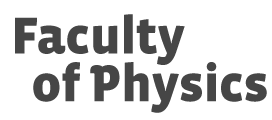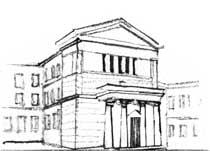Seminar of Theory of Relativity and Gravitation
2006/2007 | 2007/2008 | 2008/2009 | 2009/2010 | 2010/2011 | 2011/2012 | 2012/2013 | 2013/2014 | 2014/2015 | 2015/2016 | 2016/2017 | 2017/2018 | 2018/2019 | 2019/2020 | 2020/2021 | 2021/2022 | 2022/2023 | 2023/2024 | 2024/2025 | Seminar homepage
2017-09-29 (Friday)
Abhay Ashtekar (Pennsylvania State University)
Gravitation Waves and a Positive $\Lambda$: Challenges and Opportunities
2017-09-22 (Friday)
Krzysztof Bolejko (University of Sydney, Australia)
Emergence of spatial curvature
The Standard Cosmological Model is build upon homogeneous and isotropic Friedmann-Lemaitre-Robertson-Walker models. The spatial curvature of the Standard Cosmological Model is flat and does not change across the cosmic evolution. During my talk I will show that emerging spatial curvature is a generic feature of inhomogeneous cosmological models. The curvature emerges due to nonlinear growth of cosmic structures. The emerging spatial curvature leads to a slightly higher expansion rate of the low-redshift Universe compared to spatially flat models. Thus, the emergence of spatial curvature may explain why low-redshift (late Universe) measurements favour a higher value of the Hubble constant than inferred from the high-redshift (early Universe) data. I will also present predictions on measurements of the spatial curvature of the low-redshift Universe based on future data (from DES/LSST surveys and the Euclid satellite) and show how in the next few years cosmologists will be able to measure the spatial curvature of the low-redshift Universe. If these measurements detect any variation from spatial flatness (which is predicted by inflationary scenarios of the early universe) then this will be an observational evidence for the actual emergence of spatial curvature of our Universe. During my talk I will review the evolution of human ideas on the spatial curvature of the Universe, so anyone who is interested only in the history of cosmology (rather than theory itself) is also more than welcome to attend.
2017-06-09 (Friday)
Jerzy Lewandowski (IFT UW)
Black hole holograph
2017-06-02 (Friday)
Marco de Cesare (King's College London)
Cosmological implications of the group field theory approach to quantum gravity
I will discuss the impact of quantum gravity effects for cosmology, considering the emergent spacetime scenario based on the group field theory framework. Considering some simple models, I will show that there are significant departures from the standard picture for the history of our Universe, both at early and late times. In particular, I will show how it is possible to achieve a bounce and an early epoch of accelerated expansion in this approach. (based on Phys.Lett. B764 (2017) 49-53 and Phys.Rev. D94 (2016) no.6, 064051).
2017-05-26 (Friday)
Jerzy Kowalski-Glikman (Uniwersytet Wrocławski)
Quantum symmetries of flat quantum spacetime
By applying the Loop Quantum Gravity techniques we recently showed that in 3 dimensions the symmetry of flat spacetime in quantum gravity becomes a non-trivial Hopf algebra deformation of the Poincare algebra, known as kappa-Poincare algebra. In my talk I will describe the steps that led us to this result and then I will briefly discuss its consequences for the theory of quantum gravity and quantum gravity phenomenology.
2017-05-19 (Friday)
Maciej Dunajski (DAMTP, Cambridge)
Einstein-Weyl spaces and near horizon geometry
2017-05-12 (Friday)
Sebastian Szybka (UJ, Kraków)
Linear perturbations of the near horizon extremal Kerr geometry
2017-05-05 (Friday)
Petr Vasko (IFT UW)
Killing spinor equations: supersymmetry point of view
I will give a basic introduction to generalized Killing spinor equations. In supersymmetric QFTs these equations arise as necessary and sufficient conditions for preserving (rigid) supersymmetry on a manifold with fixed metric. Classifying manifolds which admit non-trivial solutions is an interesting problem, since it provides a list of space-times where supersymmetric theories can be consistently defined.
2017-04-28 (Friday)
Marcin Kisielowski (IFT UW)
Relation between Regge calculus and BF theory on manifolds with defects
2017-04-07 (Friday)
Mikołaj Korzyński (CFT PAN)







